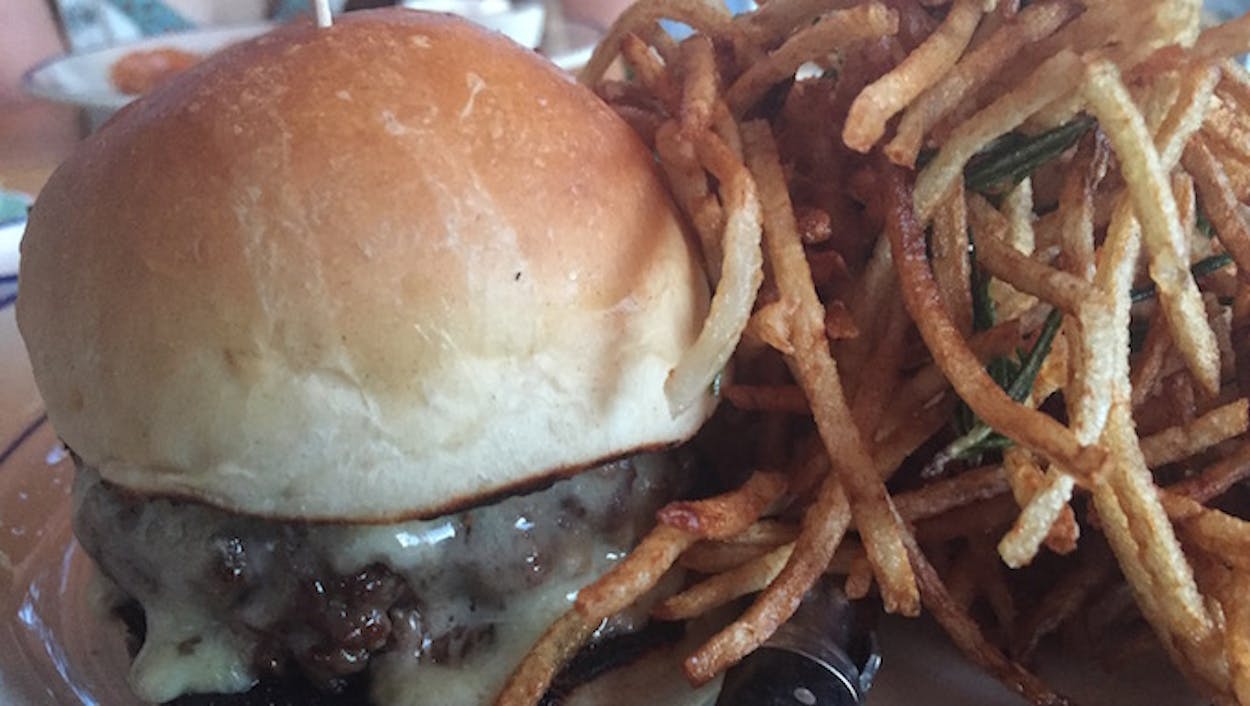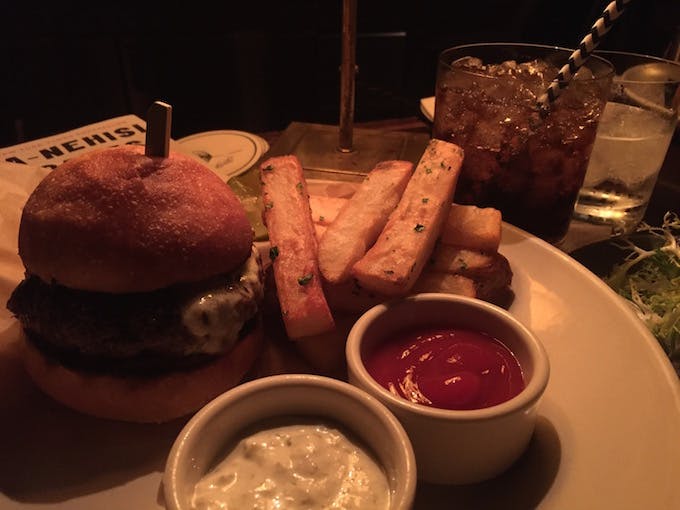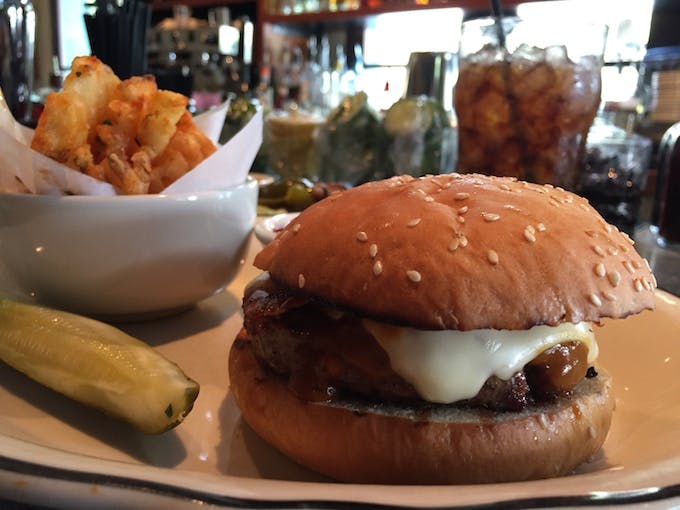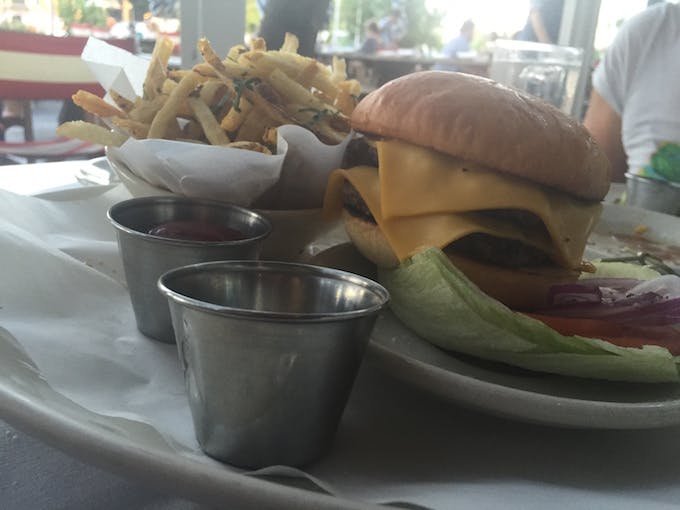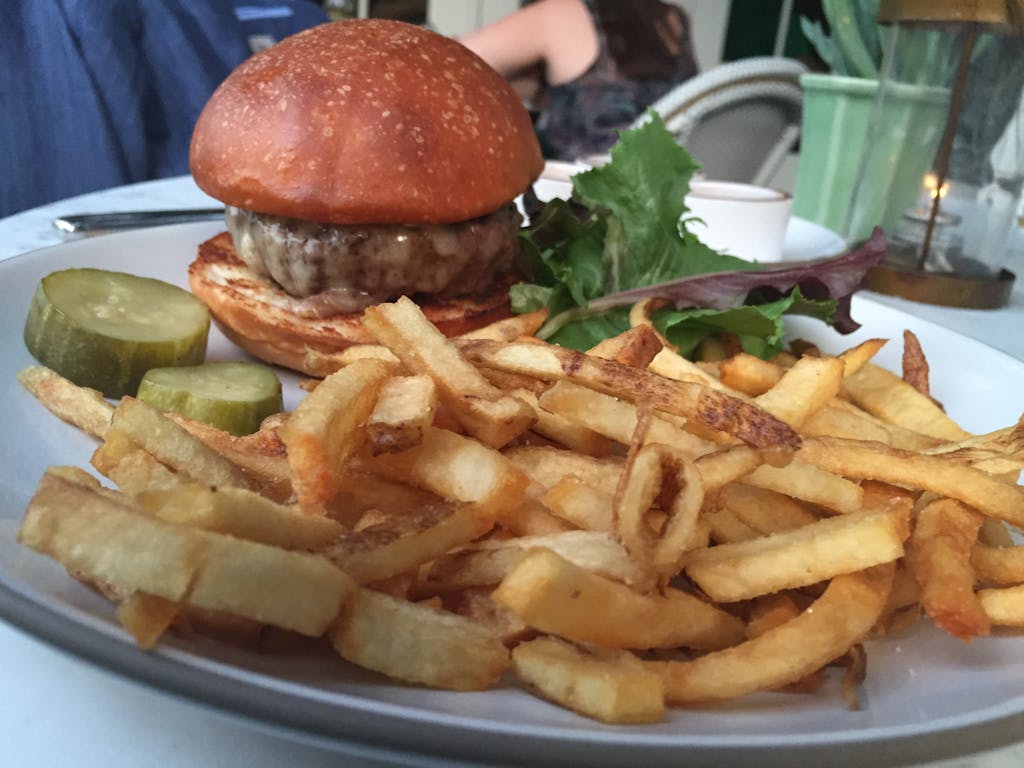Austin’s McGuire Moorman Hospitality Group operates a handful of the city’s most popular (and, sure, more expensive) restaurants. They’ve got the fancy pants BBQ joint Lambert’s downtown, the high-end French-Vietnamese place Elizabeth Street, a pair of oyster bars—Clark’s and Perla’s—and two fine dining restaurants in West Austin, Jeffrey’s and Josephine House. In August, though, they downplayed the restaurants’ specialties in favor of promoting a simpler menu item: the cheeseburger.
The restaurants participated in the 2015 Burger Challenge, which had fairly simple rules: eat a burger at all six restaurants in the month of August and win a $50 gift card to any of the group’s properties. If you eat all six burgers in a week, the reward bumps up to a $250 gift card. And, finally, if you eat more burgers at the company’s restaurants than anyone else, you win a 25 percent discount card at any MMH restaurant for a year.
The contest turned out to be popular. In fact, that’s an understatement. By August 14, MMH had nixed happy hour burgers from qualifying for the challenge. Less than a week later, they stopped passing out the punchcards that patrons used to track their burgers entirely, effectively barring new participants.
All of which leads to a question worth asking: Namely, what is it like to go high-end restaurants (the average price of a MMH cheeseburger is over $17 per meal) and eat a cheeseburger every single day for a week? To answer those questions, I did the six-day burger challenge.
Sunday, August 23
Clark’s Oyster Bar
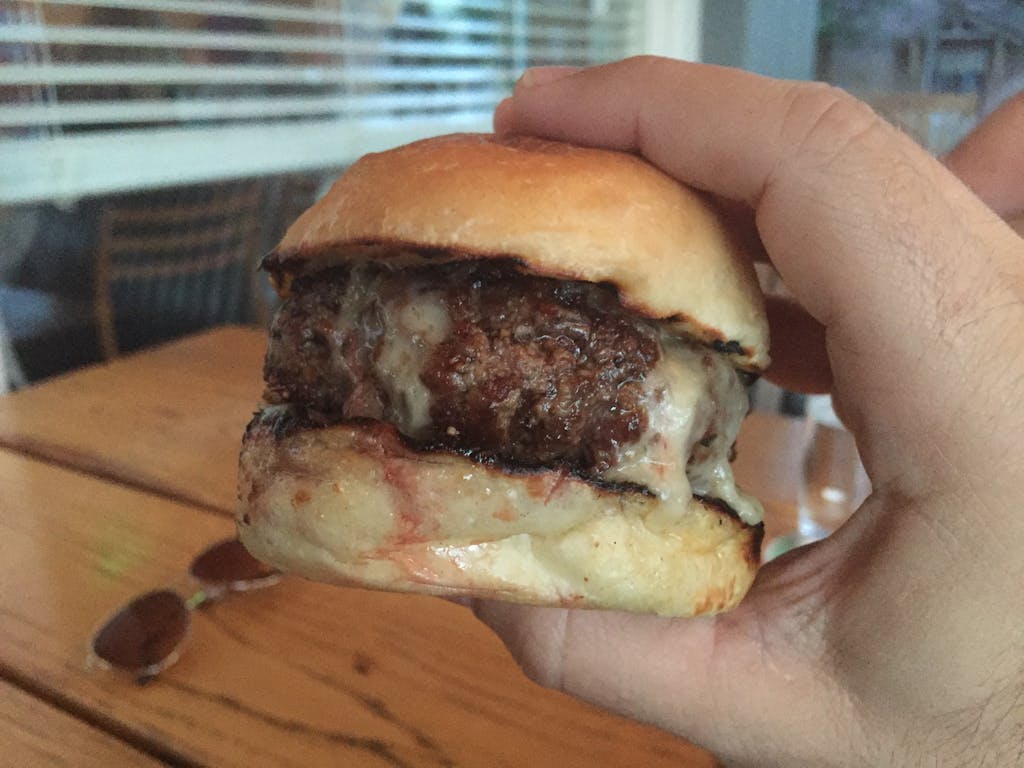
Clark’s is a nice place with a patio overlooking West Sixth Street. It has a nautical theme to match its primary offering, seafood, but they do offer a $16 cheeseburger. Look at the photo for an idea of how much burger $16 will get you—it’s a thick patty, covered in gruyere cheese, on a fresh (tiny) brioche bun. But it’s delicious (no doubt the beef is high quality), and eats like it’s a proper meal even though it’s the size of a slider. (They sell the burgers for half price during happy hour, apparently.) It comes with fries, which is an impressive mountain of tiny, thin little shoestrings.
If you don’t eat a lot of fine dining, Clark’s probably won’t intimidate you. The place is fairly relaxed, especially for a restaurant where the most expensive menu item comes in at $240. It’s that Austin spin on high-end dining, where your server has a goofy mustache and calls you “man” instead of “sir.” If that’s the experience you want, you’re in good shape at Clark’s.
I leave Clark’s feeling great about this Burger Challenge decision.
Monday, August 24
Jeffrey’s of Austin
I was nervous going to Jeffrey’s because I was going by myself. I don’t have a ton of people in my life who, on a Monday night, want to go eat at a restaurant where a cheeseburger costs $24 and a bowl of soup will run you $12. But they have bar seating (in fact, the cheeseburger is only on the bar menu), and it’s a surprisingly comfortable place to sit for an hour with only a book for company. The burger at Jeffrey’s is small, like at Clark’s, but also tasty. It comes with a homemade bun, thick-sliced pickles and large, crispy hand-cut fries.
Eating at a restaurant alone is a weird experience, especially at a place where people usually go for special occasions—does your server think that you don’t have any friends? I decided to pretend that I was in town for business, and the bartender, who took my order and brought it to me, made no attempt to puncture that illusion. Jeffrey’s is one of the most expensive places for a meal in Austin—a 14-ounce ribeye will run you $55, and if you want to add fries, that’s another $10—but it was surprisingly unpretentious with that in mind.
Two cheeseburgers in two days is more red meat than I—or any adult who wants to be healthy—ought to eat regularly, but leaving Jeffrey’s, I still feel pretty good about this endeavor.
Tuesday, August 25
Lambert’s
The burger at Lambert’s is more like what you’d expect when you think of a cheeseburger—two thick patties, a hearty slice of cheese, onions, barbecue sauce, bacon, etc. It comes with waffle fries, which I’m not all that enthused about at this point. The red meat might be the point of this challenge, but eating french fries every day is actually the part that makes me feel bad about myself.
In order to counter this “eating a cheeseburger every day for a week” thing, I made sure to ride my bike to Lambert’s so I would have an opportunity to work the sandwich off. I can’t tell if I’m getting sick of burgers at this point, or if the food at Lambert’s is kind of mediocre, but this sandwich is really just a burger—if I ordered a cheeseburger at IHOP, I would expect that it’d look and taste a lot like this. Maybe if I’d started at Lambert’s, I’d feel differently, but for my third burger in three days, my standards are apparently high.
Lambert’s is a comfortable place for lunch, though. It’s well-lit and relatively uncrowded, and eating a burger by yourself at a bar at lunch feels pretty different from doing it at dinnertime. The lack of pretension is kind of nice—at the very least, Lambert’s feels like it’d be pretty welcoming to everybody who comes in. But that casual setting is also strange, because if you’re not getting great food or a refined atmosphere, why are you spending $16 on a burger?
Wednesday, August 26th
Perla’s
I’m definitely not in the mood for a cheeseburger at this point, which is too bad, because the burger at Perla’s is a serious sandwich: two thick patties, two slices of American cheese, veggies, and a bucket of french fries. My wife ends up ordering a light, melon-based salad, and I found myself jealous.
In addition to the lack of enthusiasm I have for this cheeseburger on day four, I’m also starting to feel weird about eating at restaurants like Perla’s. There’s a conspicuous-consumption aspect to sitting on a patio on a busy commercial strip like South Congress, where Perla’s is, and showing off your willingness to overpay for food you’re not even excited about eating. At this point, I’m starting to feel a little bit like Richard Pryor’s character in Brewster’s Millions, where I’m doing something that’s supposed to be fun—eating delicious food in nice restaurants—to the point where it’s starting to become a chore.
I’m not sure what it is about Perla’s that brings this out of me—it might be the fact that the waitstaff wears matching nautical-striped t-shirts, which I imagine is supposed to conjure the feeling of being at sea, but which mostly reminds me of Tschotske’s from Office Space.
It’s a reminder that the distinction between “fine dining” and “just a restaurant” is largely arbitrary. Yes, the food is better at Perla’s than the food at, say, Joe’s Crab Shack, but the atmosphere isn’t really that different, and the fried shrimp or the cheeseburger at Perla’s cost almost twice what you’ll pay at a place like that. If the experience were dramatically improved, that might make sense—but right now, it feels like going through the effort to eat at a place like this is a lot of convincing yourself that it’s worth it.
Thursday, August 27
Josephine House
If I was just cranky at Perla’s on Wednesday, that’s all gone by the time I get to Josephine House. I’m still not really excited about the idea of eating another cheeseburger—and when it comes out with a heaping plate of french fries and some leafy greens, I’m more interested in the lettuce than I am the slab of red meat. But the place itself is delightful—we sit on a patio behind a small West Austin house that has maybe a dozen tables on it, and there are mounted fans to keep it comfortable even in the summertime.
I eaten my share of cheeseburgers in this life, and the one I’m served at Josephine House is one of the better ones I’ve had, but it also really does feel like a chore to get through the whole thing. Josephine House is a nice place—I could see myself going there for a birthday or something—but it’s definitely not a place where I intend to eat another cheeseburger, and that’s got more to do with the fact that shelling out a lot of money for a burger at a nice restaurant feels like a waste of time. There’s a whole world of culinary delights out there—why limit yourself to burgers?
Friday, August 28
Elizabeth Street
But at Elizabeth Street, “limiting yourself to burgers” isn’t really an option. In fact, there’s not even a burger on the regular menu at the Vietnamese-French restaurant—you have to ask the server for it specifically, and then you get something served with kimchi pickles, a slab of back bacon, lettuce, and rice wafers atop a bakery bun. (No cheese here, either.)
It’s kind of a perfect end to this experiment, because I’m not excited about ordering yet another burger, my server isn’t excited about bringing it out, and the restaurant isn’t excited enough about its creation to, you know, put it on the menu. At some point, the idea of eating in nice restaurants with diverse menus only to get the same exact thing—a sandwich that you can also get for $0.99 without having to leave your car at two in the morning—feels downright ridiculous, and the absurd-looking sandwich served to me at Elizabeth Street highlights that.
I’m going to guess that the average burger at each of the six restaurants I’ve had was 1/3 pound, which means I’ve consumed about 32 ounces of red meat in six days. It’s not a great feeling physically. It won’t make you sick or anything, but it’s a heavier feeling than if you’d moderated yourself to a healthy intake. But it’s also a strange feeling emotionally. I ate half of my meals alone, and half with my wife. We dropped over $200—no doubt a price premium paid for better quality ingredients—on those nine plates of food. The experience, while novel out of the gate, proved to be not for me. It also laid bare the growing pains of Austin’s food scene, where some of the nicest restaurants in the city—like the ones by McGuire Moorman Hospitality Group, which are admittedly elevating finer dining to a level Houston and Dallas have long enjoyed—appear a little precious about their cleverness and niftiness, a feat that’s not too difficult in a market that’s only now catching up to its big-city counterparts.
The idea that the burger challenge was such a huge success that it blew the doors off of all six of the participating restaurants is hard for me to imagine. I don’t feel good about myself after eating so many burgers—maybe that’s the abundance of french fries I’ve been served—or eating the same thing every day. Again, the gimmick by MMH—the Wes Anderson of restaurant groups—is cute, and it’s word-of-mouth marketing tactic clearly worked. But what’s the appeal of going to so many restaurants with a diverse menu, and eating the same thing at all of them? If you can afford to drop the kind of money it takes to eat at Josephine House or Jeffrey’s on a lark, then you can’t be that desperate for the $250 gift card. Is everybody else who’s been doing this chasing the same weird goal that I am, to eat all of these burgers just to see how it feels? What kind of person do you have to be to relish the nuanced differences between each of the six burgers you wolfed down in six days? And what does it say about our foodie culture in general?
I like cheeseburgers, and I like nice restaurants, and I like ridiculous gastronomical challenges, but those are all things I like best in moderation. If you overindulge on any of them, you’re likely to end up questioning how much any of them are worth—and desperately craving vegetables.


